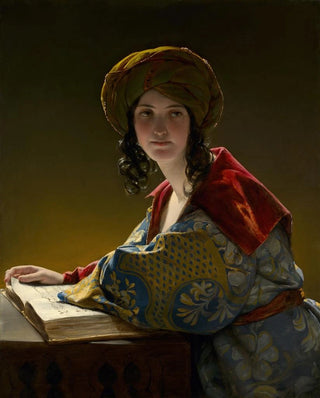Art print | The young Oriental woman - Friedrich von Amerling Source: Reproduction | La jeune femme orientale - Friedrich von Amerling


View from behind

Frame (optional)
In the fascinating universe of art, some works transcend time and space, captivating the eye and the soul. "The Young Oriental Woman" by Friedrich von Amerling stands out as a dazzling example of harmony between beauty and expression. This painting, created in the mid-19th century, evokes a world that is both distant and close, a fusion of cultures that invites contemplation. The depiction of an orientalist woman, both mysterious and elegant, immerses us in an atmosphere filled with exoticism and delicacy. The artist's technical mastery, combined with a rich and nuanced palette, creates a piece that leaves no one indifferent.
Style and uniqueness of the work
Friedrich von Amerling's style is characterized by fine details and a particular attention to light. In "The Young Oriental Woman," every brushstroke seems to be a tribute to the splendor of femininity. The texture of the clothing, the reflections of light on the skin, and the decorative elements surrounding the subject are all testimonies to the artist's skill in capturing beauty in its subtle nuances. Amerling, as a portraitist, knows how to magnify his models, endowing them with an almost mythical aura. The pose of the young woman, imbued with grace and serenity, suggests a certain introspection, as if she is both aware of her gaze and the stories she could tell. This blend of intimacy and distance creates a unique connection between the artwork and the viewer, an invitation to explore the emotions and stories buried behind this delicate face.
The artist and his influence
Friedrich von Amerling, an emblematic figure of the 19th century, managed to establish himself in the art world thanks to his exceptional talent and artistic vision. Born in 1803 in Vienna, he was influenced by the romantic currents of his time but also incorporated elements of classicism. His work is distinguished by a capacity to grasp the very essence of his subjects' personalities, while placing them in contexts that evoke broader narratives. Amerling had a significant impact on his contemporaries

Matte finish

View from behind

Frame (optional)
In the fascinating universe of art, some works transcend time and space, captivating the eye and the soul. "The Young Oriental Woman" by Friedrich von Amerling stands out as a dazzling example of harmony between beauty and expression. This painting, created in the mid-19th century, evokes a world that is both distant and close, a fusion of cultures that invites contemplation. The depiction of an orientalist woman, both mysterious and elegant, immerses us in an atmosphere filled with exoticism and delicacy. The artist's technical mastery, combined with a rich and nuanced palette, creates a piece that leaves no one indifferent.
Style and uniqueness of the work
Friedrich von Amerling's style is characterized by fine details and a particular attention to light. In "The Young Oriental Woman," every brushstroke seems to be a tribute to the splendor of femininity. The texture of the clothing, the reflections of light on the skin, and the decorative elements surrounding the subject are all testimonies to the artist's skill in capturing beauty in its subtle nuances. Amerling, as a portraitist, knows how to magnify his models, endowing them with an almost mythical aura. The pose of the young woman, imbued with grace and serenity, suggests a certain introspection, as if she is both aware of her gaze and the stories she could tell. This blend of intimacy and distance creates a unique connection between the artwork and the viewer, an invitation to explore the emotions and stories buried behind this delicate face.
The artist and his influence
Friedrich von Amerling, an emblematic figure of the 19th century, managed to establish himself in the art world thanks to his exceptional talent and artistic vision. Born in 1803 in Vienna, he was influenced by the romantic currents of his time but also incorporated elements of classicism. His work is distinguished by a capacity to grasp the very essence of his subjects' personalities, while placing them in contexts that evoke broader narratives. Amerling had a significant impact on his contemporaries






